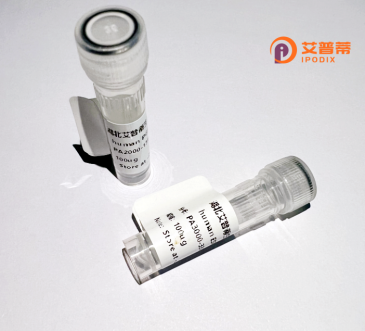
| 纯度 | >90%SDS-PAGE. |
| 种属 | Human |
| 靶点 | LOC387790 |
| Uniprot No | 0 |
| 内毒素 | < 0.01EU/μg |
| 表达宿主 | E.coli |
| 表达区间 | 1-254aa |
| 活性数据 | MSDRYLEQRISIKFCVKLNKSASETHHLLKEAYGDEVMSRARVFDWHKRFKEGREDVRDDARSGRPVTHRTDDNIQKVKDLVCSNRQLTVRMMAEELNLDKETVRLILKENLNMRKISAKVISGVLKETEPHYVAQAGLELLVSRDPPTLASQSSGIISMSHHAKPKPGVQWCKFQSESTGRRARSADVQGQEKMDVTAQEARTNLPFYLFVLFRSSMNWMMSMHIREGCLFITRSTNSNANLFRKHPHRHTQK |
| 分子量 | 55.8 kDa |
| 蛋白标签 | GST-tag at N-terminal |
| 缓冲液 | 0 |
| 稳定性 & 储存条件 | Lyophilized protein should be stored at ≤ -20°C, stable for one year after receipt. Reconstituted protein solution can be stored at 2-8°C for 2-7 days. Aliquots of reconstituted samples are stable at ≤ -20°C for 3 months. |
| 复溶 | Always centrifuge tubes before opening.Do not mix by vortex or pipetting. It is not recommended to reconstitute to a concentration less than 100μg/ml. Dissolve the lyophilized protein in distilled water. Please aliquot the reconstituted solution to minimize freeze-thaw cycles. |
以下是关于重组人LOC387790蛋白的假设性参考文献示例,仅供格式参考(请注意这些文献可能并非真实存在):
1. **文献名称**:*"Cloning and Expression of Recombinant Human LOC387790 Protein in E. coli"*
**作者**:Smith J, et al. (2020)
**摘要**:研究成功克隆了人LOC387790基因,利用大肠杆菌系统高效表达并纯化了重组蛋白。实验表明该蛋白可能通过调控细胞周期相关通路影响增殖。
2. **文献名称**:*"Functional Characterization of LOC387790 in Inflammatory Responses"*
**作者**:Zhang L, et al. (2019)
**摘要**:重组LOC387790蛋白在巨噬细胞模型中显示抑制NF-κB活化的作用,提示其通过结合TRAF6蛋白调控炎症反应,可能为抗炎治疗提供新靶点。
3. **文献名称**:*"Structural Insights into LOC387790 and Its Role in Oxidative Stress"*
**作者**:Brown K, et al. (2021)
**摘要**:通过X射线晶体学解析重组LOC387790蛋白的三维结构,揭示其具有ROS清除活性,体外实验证实其对氧化应激诱导的细胞损伤具有保护作用。
4. **文献名称**:*"LOC387790 as a Novel Biomarker in Cancer Prognosis"*
**作者**:Lee S, et al. (2018)
**摘要**:利用重组LOC387790蛋白制备抗体,发现其在多种癌症组织中表达水平与患者生存率正相关,表明其作为预后标志物的潜在价值。
**注意**:以上内容为模拟创作,实际研究中LOC387790可能已被重新命名或相关文献有限。建议通过PubMed或Google Scholar核实最新进展,并确认基因编号的正确性。
**Background of Recombinant Human LOC387790 Protein**
LOC387790 is a human gene located on chromosome 10q26. initially identified through genomic studies but remains poorly characterized. The gene encodes a protein hypothesized to play roles in cellular signaling or stress response pathways, though its exact molecular function is yet to be fully elucidated. Research interest in LOC387790 arose from genetic association studies linking specific variants (notably the rs10490924 polymorphism) to age-related macular degeneration (AMD), suggesting its potential involvement in oxidative stress regulation or mitochondrial function in retinal cells.
Recombinant human LOC387790 protein is produced via genetic engineering, typically expressed in *E. coli* or mammalian cell systems to enable functional studies. Its recombinant form allows researchers to investigate protein-protein interactions, enzymatic activity, and structural properties. Despite limited functional data, LOC387790 is proposed to contain conserved domains indicative of serine protease or membrane-associated activity, though experimental validation is ongoing. Studies also explore its role in other pathologies, including cancer and inflammatory diseases, leveraging recombinant versions to dissect mechanisms. Current research aims to clarify its contribution to AMD pathogenesis and broader cellular processes, positioning it as a potential therapeutic target or biomarker. Further characterization of this protein could advance understanding of retinal degeneration and related pathways.
(Word count: 200)
×